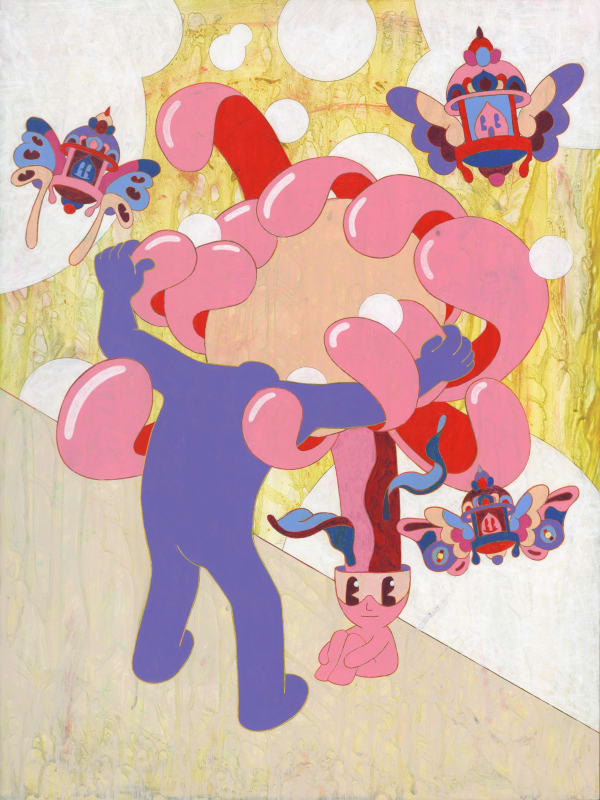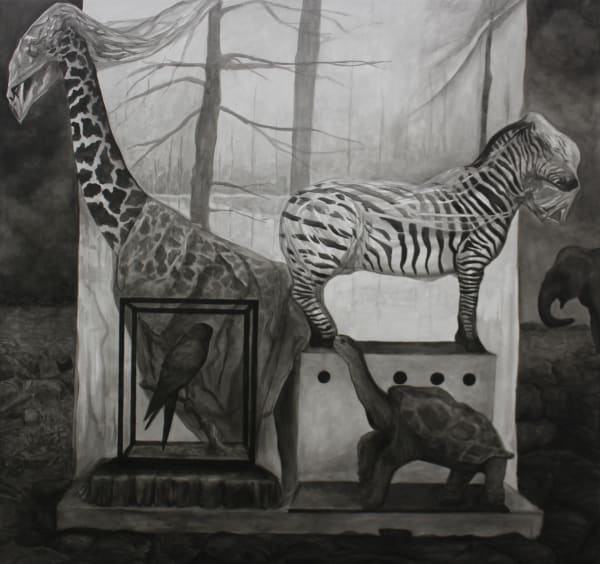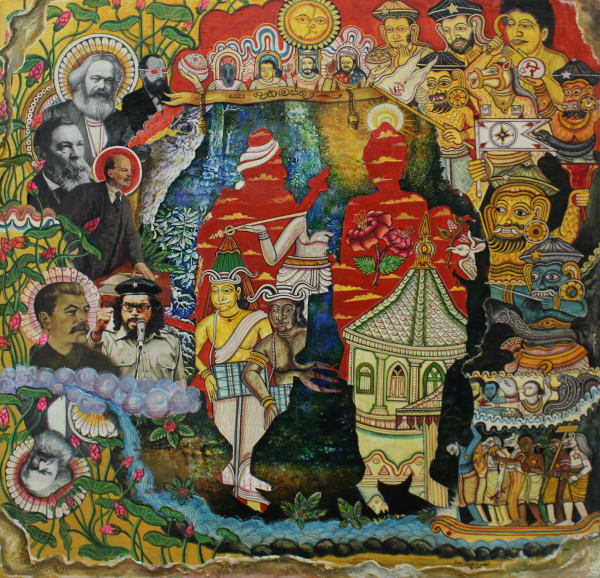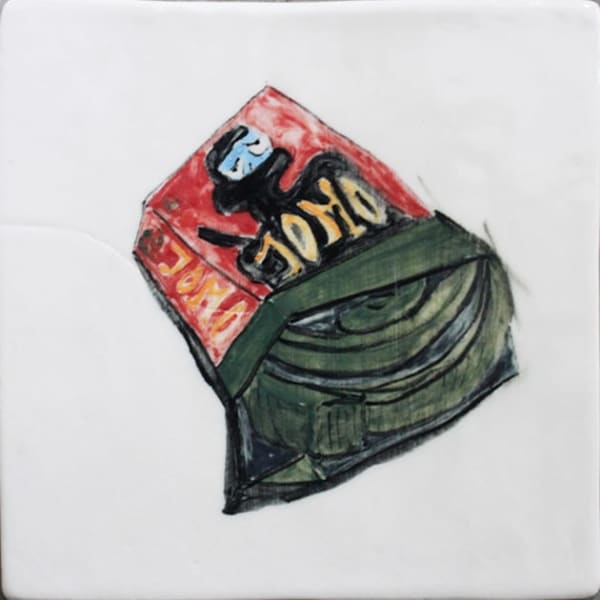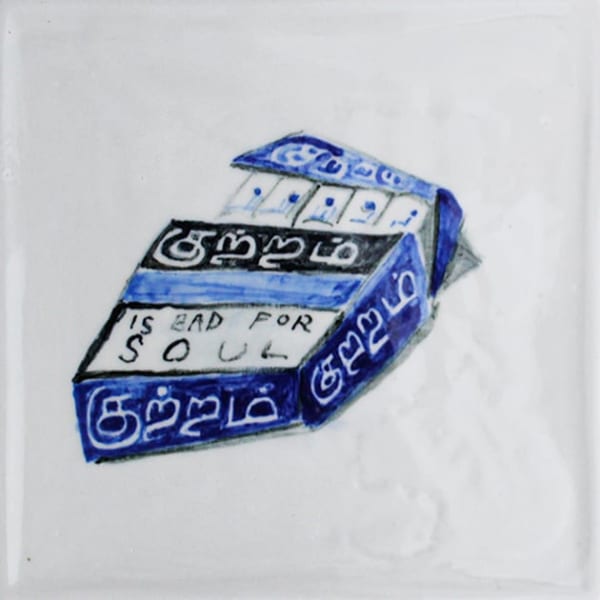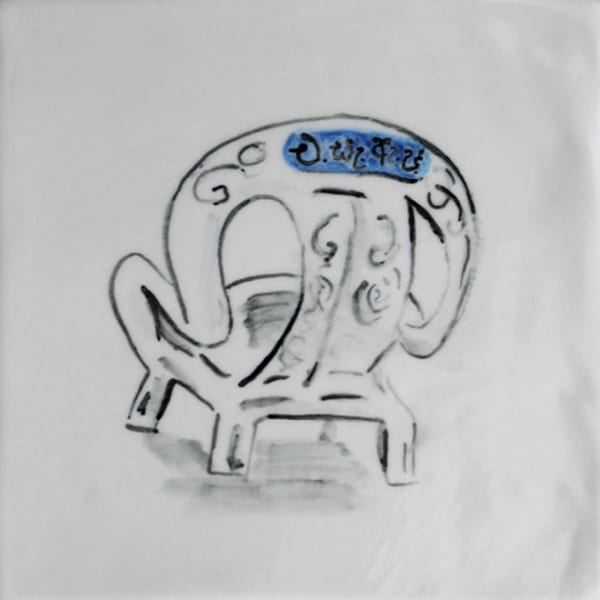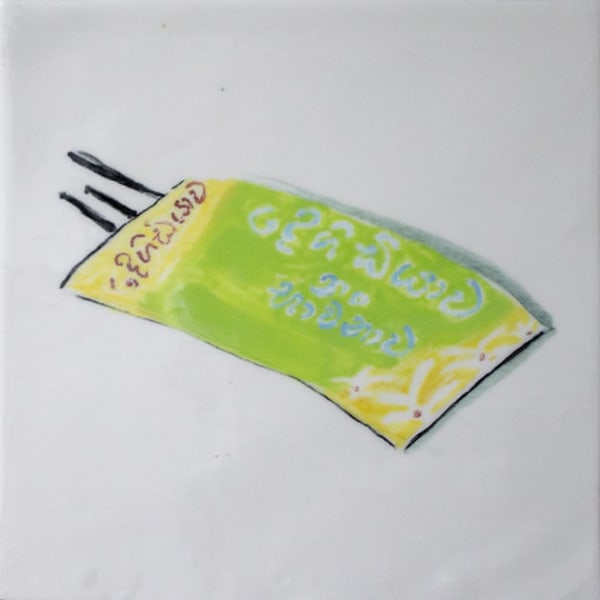served to you with a dash of lime
Muvindu Binoy, Hashan Cooray, Kumkum Fernando, Arjuna Gunarathne, Kavishwara Jayasekara, Mayun Kaluthantri, Mahesha Kariyapperuma, Sangeeth Madurawala, Murugiah, Anupa Perera, Gayan Prageeth, Firi Rahman, Mika Tennekoon, Pradeep Thalawatta
Curated by Mariyam Begum and Sulakshi Ratnayake
Served to you with a dash of lime is a provocation – to acknowledge the messy contradictions of our world with joy and good humour. Borne from an observation of weighty critical discourse in art, this exhibition ventures into the idea of play and laughter as valid and often vital tools of engagement. The intent is to bring together work from Sri Lanka and its diaspora that takes an off-the-cuff approach to negotiate contemporary realities, functioning not as an escape but as a porous entry point into contentious conversations. Here you encounter a different kind of criticality – one that is laced with levity.
Leaning into a self aware humor that entertains derision, Gayan Prageeth and Sangeeth Madurawala offer razor sharp observations of society. Delivered with an acidic punch, they charm the viewer with a devious intellect and cautious sarcasm. Gayan Prageeth celebrates our obsessions. Visualizing a mannequin in an outrageously ornate homecoming dress the artist notes our fascination with grand wedding celebrations and western traditions. The work becomes a subversive celebration of expectations to surrender autonomy within the institutions of marriage – reinforced in the present by rigid colonial expectations. A similar hyperbolic aesthetic is at play in Sangeeth Madurawala’s digital collages where the women appear pretty as a picture in their virtuous and virginal altars. Tussle with sacred icons, homely relics, bombs and bullets they tease the burning question – what’s a little divine intervention in the explosive theatre of gender politics?
Touting the line between satire and absurdity, Anupa Perera and Kavishwara Jayasekara hold a mirror to the comedy of errors that define the contemporary moment. Jayasekara reinterprets motifs and themes in traditional mural paintings, fashioning our enchantment with nationalist histories into tools to comment on the island's shifting political landscape. Adapted with a sharp subtlety, the demons wielding sickles underscore the seductive potency of traditions to entice both the polity and authority which aspires for change. Evoking a plasticine quality through figurines of Jesus, his apostles, and posters depicting the devolution of human species into barcodes, Anupa Perera makes a mockery of humans as ‘moral beings’. Peppered with pop culture references, his commentary on disavowal and desensitization is made sharper by the overall toyish appearance.
Reality is suspended at a momentary bridge created by the frivolity and weightlessness the act of play offers, where grim realities can be exchanged for merry enjoyment. Mayun Kaluthantri returns to the simple joy of clay—the subtle thrill of feeling it yielding beneath the hand—as an act of slowing down. In a world dizzy with labels and products, hazy images of monobloc chairs and mosquito coils accompanied by light platitudes are transformed into tender relics of an effervescent childhood. Playing off the bright and catchy language of advertisements and billboards, Hashan Cooray taps into the excitement and novelty it offers to comment on the enmeshment between consumerism and free will. In his work a jigsaw puzzle that is more unresolved than solved becomes a quip on the products we consume and covet, defining how we choose to shape our identities. Mahesha Kariyapperuma takes the playing card for a spin mimicking the intellectual waltz that takes place in virtual spaces. The temperamental Joker acts as a proxy for the divided opinions on uncertain economic futures and aspirations.
Flippant and feisty, the defiant imagination scoffs at solemnity – unbothered by the need to explain. In this paradigm, animals and birds become cheeky interlocutors in Firi Rahman’s imagination. They flip narrative led by human vanity on its tail, claiming agency by becoming the very objects they covet. Emboldened by a grunge aesthetic, Muvindu Binoy mirrors the online over stimulation and fragmented attention spans. The visual splinters from anime, memes and internet ‘brain rot’ captures a confused generation’s attempt to make sense of a cultural ‘glitch’.
Alternate ways of experiencing the world can be realized through unhinged, unbridled imaginations. Spontaneity and a zeal for wicked fun become liberating forces , permitting the invention of a new lexicon and visual grammar to tell our stories. The sugary dreamscapes playfully lace with South Asian iconography in Murugiah’s work, twiddling between surreal escapes and celebration of hybrid textures of diasporic life. In imagining a swashbuckling sci-fi adventure, at once ancient and futuristic, Kumkum Fernando crafts narratives that de-centers the colonial histories of the Global South. Blending remnants of the French colonial architecture with Hindu myths and folktales the artist takes a whimsical flight, where myth and memory traverse non-linear timelines to reimagine how postcolonial histories are constructed.
Characterized by the bittersweet longing for places and people that contain joy, Pradeep Thalawatta and Mika Tennekoon reach out to tender memories in search of comforting respite. Thalawatta captures the fleeting moments in which skies vividly come alive. Working on cement bags collected from construction sites, the artist reclaims the sky from the multi-storied outcroppings, responding to the weight of solastalgia. Tennekoon, seeks the softness of inherited humour as a radical intervention in an age of crisis fatigue, and moral contradictions. Latin phrases used in naming plants and idiosyncratic sayings of a father work like spell work, becoming magical incantations. Illustrations on ledger paper intertwine with text, gesture, and botanical elements - both real and invented, challenge the seriousness of our times. Arjuna Gunarathne fashions a parallel universe enriched with celebration and mirth, as he navigates a life as an immigrant in a foreign land. The candy-coloured hills the artist inhabits with his family become a sanctuary from disorientation where magic prevails in the ordinary and intimate company of loved ones.
The sweet and sour collude in the exhibition through the works of fourteen artists who operate from the in-between, oscillating between inherited traumas and self determined joy, between the mythologised homeland and belonging elsewhere and between the heaviness of crisis and the lightness of play. The act of disarming and delighting become modes for a spirited reimagination of existing structures, challenging prevailing hypocrisies, and conjuring alternate truths as they continue to resist the complexities of the here and now. With a tactical frivolity these artists arouse laughter of all kinds – a knowing snicker, a warm smile or a just good old belly laugh – reminding us of the potency of joy as both critical apparatus and healing salve.
-
 MurugiahWake me up when it's over, 2025Acrylic on Wood61 x 45 x 4 cm
MurugiahWake me up when it's over, 2025Acrylic on Wood61 x 45 x 4 cm
24 x 17 3/4 x 1 5/8 in -
 Firi RahmanFeeling So Exotic, 2025Acrylic on Canvas122 x 122 cm
Firi RahmanFeeling So Exotic, 2025Acrylic on Canvas122 x 122 cm
48 x 48 in -
 Sangeeth MadurawalaHer voice under the bullet, 2025Giclée Print on Archival Photo Paper80 x 60 cm
Sangeeth MadurawalaHer voice under the bullet, 2025Giclée Print on Archival Photo Paper80 x 60 cm
31 1/2 x 23 5/8 inEdition of 3 -
 Sangeeth MadurawalaWant to hurt me, 2025Giclée Print on Archival Photo Paper80 x 60 cm
Sangeeth MadurawalaWant to hurt me, 2025Giclée Print on Archival Photo Paper80 x 60 cm
31 1/2 x 23 5/8 inEdition of 3
-
 Gayan PrageethTo Behold and To Cherish, 2025Acrylic on Canvas183 x 123 cm
Gayan PrageethTo Behold and To Cherish, 2025Acrylic on Canvas183 x 123 cm
72 x 48 3/8 in -
 Kumkum FernandoKoha (K03), 2025Mixed Media Wooden Sculpture36 x 19 x 11 cm
Kumkum FernandoKoha (K03), 2025Mixed Media Wooden Sculpture36 x 19 x 11 cm
14 1/8 x 7 1/2 x 4 3/8 in -
 Kumkum FernandoLomba (L17), 2025Mixed Media Wooden Sculpture35 x 22 x 12 cm
Kumkum FernandoLomba (L17), 2025Mixed Media Wooden Sculpture35 x 22 x 12 cm
13 3/4 x 8 5/8 x 4 3/4 in -
 Kumkum FernandoManike the Maniac (M09), 2025Mixed Media Wooden Sculpture40 x 26 x 9 cm
Kumkum FernandoManike the Maniac (M09), 2025Mixed Media Wooden Sculpture40 x 26 x 9 cm
15 3/4 x 10 1/4 x 3 1/2 in
-
 Kumkum FernandoSoft Boss (B06), 2025Mixed Media Wooden Sculpture36 x 22 x 11 cm
Kumkum FernandoSoft Boss (B06), 2025Mixed Media Wooden Sculpture36 x 22 x 11 cm
14 1/8 x 8 5/8 x 4 3/8 in -
 Anupa PereraRestless Desire , 2024Oil on Canvas69 x 99.5 cm
Anupa PereraRestless Desire , 2024Oil on Canvas69 x 99.5 cm
27 1/8 x 39 1/8 in -
 Kavishwara Jayasekarakal yugaya, yuganthaya , 2025Mixed Media on Canvas61 x 61 cm
Kavishwara Jayasekarakal yugaya, yuganthaya , 2025Mixed Media on Canvas61 x 61 cm
24 x 24 in -
 Hashan CoorayIn Case of Emergency, Consume I, 2025Collage, Drawing, Craft Paper, Found Posters, Drawing Pins on Wooden Board122 x 92 cm
Hashan CoorayIn Case of Emergency, Consume I, 2025Collage, Drawing, Craft Paper, Found Posters, Drawing Pins on Wooden Board122 x 92 cm
48 x 36 1/4 in
-
 Hashan CoorayIn Case of Emergency, Consume III, 2025Mixed Media on a Canvas Pad30 x 25 cm
Hashan CoorayIn Case of Emergency, Consume III, 2025Mixed Media on a Canvas Pad30 x 25 cm
11 3/4 x 9 7/8 in -
 Hashan CoorayIn Case of Emergency, Consume II , 2025Mixed Media SculptureVariable
Hashan CoorayIn Case of Emergency, Consume II , 2025Mixed Media SculptureVariable -
 Mahesha KariyapperumaBittersweet, 2025Giclée Print on Archival Photo Paper42 x 30 cm
Mahesha KariyapperumaBittersweet, 2025Giclée Print on Archival Photo Paper42 x 30 cm
16 1/2 x 11 3/4 inEdition of 5 -
 Mahesha KariyapperumaNote and the Boat, 2025Giclée Print on Archival Photo Paper42 x 30 cm
Mahesha KariyapperumaNote and the Boat, 2025Giclée Print on Archival Photo Paper42 x 30 cm
16 1/2 x 11 3/4 inEdition of 5
-
 Mahesha KariyapperumaSplit Spirit, 2025Giclée Print on Archival Photo Paper42 x 30 cm
Mahesha KariyapperumaSplit Spirit, 2025Giclée Print on Archival Photo Paper42 x 30 cm
16 1/2 x 11 3/4 inEdition of 5 -
 Mayun KaluthanthriJ.O.M.O / The Joy of Missing Out!, 2025Ceramic Tablet16 x 16 cm
Mayun KaluthanthriJ.O.M.O / The Joy of Missing Out!, 2025Ceramic Tablet16 x 16 cm
6 1/4 x 6 1/4 in -
 Mayun KaluthanthriUnder/Over සිතන්න / Under/Over Think It!, 2025Ceramic Tablet16 x 16 cm
Mayun KaluthanthriUnder/Over සිතන්න / Under/Over Think It!, 2025Ceramic Tablet16 x 16 cm
6 1/4 x 6 1/4 in -
 Mayun Kaluthanthriகுற்றம் is Bad for the Soul / Guilt is Bad for the Soul, 2025Ceramic Tablet16 x 16 cm
Mayun Kaluthanthriகுற்றம் is Bad for the Soul / Guilt is Bad for the Soul, 2025Ceramic Tablet16 x 16 cm
6 1/4 x 6 1/4 in
-
 Mayun Kaluthanthriඒ.සැ.ඇ.ප්. / As Slow As Possible., 2025Ceramic Tablet16 x 16 cm
Mayun Kaluthanthriඒ.සැ.ඇ.ප්. / As Slow As Possible., 2025Ceramic Tablet16 x 16 cm
6 1/4 x 6 1/4 in -
 Mayun Kaluthanthriදෙගිඩියාව නම් භාවනාව / Hesitate Just Meditate, 2025Ceramic Tablet16 x 16 cm
Mayun Kaluthanthriදෙගිඩියාව නම් භාවනාව / Hesitate Just Meditate, 2025Ceramic Tablet16 x 16 cm
6 1/4 x 6 1/4 in -
 Pradeep ThalawattaThe Negative Space of Silence and the Tarred Text V, 2024Tar and Collage on Sandpaper28 x 23 cm
Pradeep ThalawattaThe Negative Space of Silence and the Tarred Text V, 2024Tar and Collage on Sandpaper28 x 23 cm
11 x 9 in -
 Pradeep ThalawattaThe Negative Space of Silence and the Tarred Text V, 2024Tar and Collage on Sandpaper28 x 23 cm
Pradeep ThalawattaThe Negative Space of Silence and the Tarred Text V, 2024Tar and Collage on Sandpaper28 x 23 cm
11 x 9 in
-
 Pradeep ThalawattaSanded Land I, 2025Acrylic on Found Sandpaper27 x 23 cm
Pradeep ThalawattaSanded Land I, 2025Acrylic on Found Sandpaper27 x 23 cm
10 5/8 x 9 in -
 Pradeep ThalawattaSanded Land II, 2025Acrylic on Found Sandpaper27 x 23 cm
Pradeep ThalawattaSanded Land II, 2025Acrylic on Found Sandpaper27 x 23 cm
10 5/8 x 9 in -
 Pradeep ThalawattaSanded Land III, 2025Acrylic on Found Sandpaper27 x 23 cm
Pradeep ThalawattaSanded Land III, 2025Acrylic on Found Sandpaper27 x 23 cm
10 5/8 x 9 in -
 Pradeep ThalawattaSanded Land IV, 2025Acrylic on Found Sandpaper27 x 23 cm
Pradeep ThalawattaSanded Land IV, 2025Acrylic on Found Sandpaper27 x 23 cm
10 5/8 x 9 in
-
 Pradeep ThalawattaSanded Land V, 2025Acrylic on Found Sandpaper27 x 23 cm
Pradeep ThalawattaSanded Land V, 2025Acrylic on Found Sandpaper27 x 23 cm
10 5/8 x 9 in -
 Pradeep ThalawattaSanded Land VI, 2025Acrylic on Found Sandpaper27 x 23 cm
Pradeep ThalawattaSanded Land VI, 2025Acrylic on Found Sandpaper27 x 23 cm
10 5/8 x 9 in -
 Mika TennekoonAntirrhinum majus, 2025Watercolour, Pressed Flowers and Natural Pigment on Stained Ledger Paper32 x 20 cm
Mika TennekoonAntirrhinum majus, 2025Watercolour, Pressed Flowers and Natural Pigment on Stained Ledger Paper32 x 20 cm
12 5/8 x 7 7/8 in -
 Mika TennekoonCaeruleum rosa, 2025Watercolour, Pressed Flowers and Natural Pigment on Stained Ledger Paper32 x 20 cm
Mika TennekoonCaeruleum rosa, 2025Watercolour, Pressed Flowers and Natural Pigment on Stained Ledger Paper32 x 20 cm
12 5/8 x 7 7/8 in
-
 Mika TennekoonIpomea biloba, 2025Watercolour, Pressed Flowers and Natural Pigment on Stained Ledger Paper32 x 20 cm
Mika TennekoonIpomea biloba, 2025Watercolour, Pressed Flowers and Natural Pigment on Stained Ledger Paper32 x 20 cm
12 5/8 x 7 7/8 in -
 Mika TennekoonSpinifex longifolius, 2025Watercolour, Pressed Flowers and Natural Pigment on Stained Ledger Paper32 x 20 cm
Mika TennekoonSpinifex longifolius, 2025Watercolour, Pressed Flowers and Natural Pigment on Stained Ledger Paper32 x 20 cm
12 5/8 x 7 7/8 in -
 Arjuna GunarathneTime to go home, 2024Crayon on Paper15 x 21 cm
Arjuna GunarathneTime to go home, 2024Crayon on Paper15 x 21 cm
5 7/8 x 8 1/4 in -
 Arjuna GunarathneDon't fall asleep, 2024Crayon on Paper15 x 21 cm
Arjuna GunarathneDon't fall asleep, 2024Crayon on Paper15 x 21 cm
5 7/8 x 8 1/4 in

